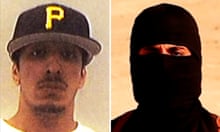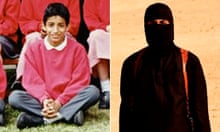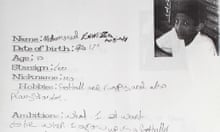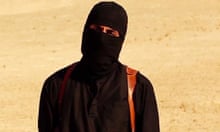The British man who was named as the extremist glorying in the beheading of journalists and aid workers had been known to intelligence agencies for five years before he publicly emerged in a series of grisly Islamic State (Isis) propaganda videos.
It has been confirmed to the Guardian that Mohammad Emwazi, a 26-year-old Londoner and computer studies graduate, is the militant labelled “Jihadi John” who has claimed responsibility for the beheadings of at least seven US, British and other hostages.
Emails and other documents that emerged on Thursday also showed that security services had been tracking Emwazi since 2009, starting when he was refused entry to Tanzania, until the middle of 2013 when they informed his family that he had crossed over to Syria.
During that period Emwazi complained on occasion that he had been harassed by MI5, but the Kuwaiti-born Briton eventually disappeared before arriving on the world stage as the murderous public face of Isis in August 2014.
Sir Menzies Campbell, an outgoing member of the intelligence and security committee, said he expected MPs to seek a report from the intelligence agencies about agency contacts with Emwazi after the election.
Campbell said the case appeared to have echoes of the 2013 murder of Lee Rigby, one of whose killers, Michael Adebolajo, later turned out to be known to security agencies. “One of the difficulties here is you can’t keep an eye on everyone all the time, and as the committee found in the case of Lee Rigby, there’s no doubt that from time to time the security services have got to prioritise those upon whom they are conducting surveillance,” he said.
Asim Qureshi, the research director of Cage, an advocacy group working with victims of the “war on terror”, said Emwazi’s repeated detention and interrogation by the security services would have ended up making him susceptible to radicalisation. Cage had previously advised Emwazi when he was complaining about his treatment five years ago.
Emwazi was refused permission to enter Tanzania in August 2009, and he told Cage that he was put on a plane to the Netherlands where he was questioned by MI5. In a subsequent series of emails sent to Cage, Emwazi said the British officer knew “everything about me; where I lived, what I did, and the people I hanged around with”.
He said that he was asked to become an informant but refused – and the MI5 officer was alleged to have said that “life would be harder”.
Emwazi’s name was first published by the Washington Post on Thursday morning. Strenuous efforts appear to have been made to cover his tracks on the internet.
The Briton guarded western hostages and handled negotiations with their families. By all accounts he is a ruthless killer who has shown little compunction when it came to the on-screen murders.
The daughter of British aid worker David Haines, who was killed in September, told ITV News that identifying the masked man was “a good step”. “But I think all the families will feel closure and relief once there’s a bullet between his eyes,” Bethany Haines said.
The family of Steven Sotloff – the journalist who was apparently killed shortly before Haines – said they hoped his killer would be caught and go to prison. They said they felt relieved and took comfort after Emwazi’s identity was revealed, according to the BBC.
“We want to sit in a courtroom, watch him sentenced and see him sent to a super-max prison where he will spend the rest of his life in isolation,” the family added, according to the BBC.
Emwazi was born in Kuwait and arrived in Britain aged six. He grew up in west London and was known as a polite, mild-mannered young man. His family were said last night to be “in shock and cannot believe it is him”.
Emwazi graduated in 2009 in information technology and is also fluent in Arabic. However, instead of building a computing career, Emwazi ended up on MI5’s radar.
Over the course of a year he claimed to have been harassed and intimidated by the security services. In 2010, he went as far as to file a complaint with the Independent Police Complaints Commission over his alleged treatment.
A US government official confirmed Emwazi’s identity to the Guardian, after the British security services declined to confirm or deny that he was the masked figure in the videos. Downing Street also declined to comment.
David Cameron’s deputy spokeswoman said: “We cannot confirm or deny anything in relation to intelligence. The point the prime minister would make, which we have said since we have seen the awful actions of these Isil [Isis] terrorists, is that we are absolutely determined to bring the perpetrators to justice. The police and security agencies have been working hard to do that.”
As Isis’s public face, Emwazi has been the centre of a global manhunt, with reports last November that he had been injured in US air strikes on militant positions.
As early as September last year, MI5 and the FBI had identified Emwazi as the masked killer – just a few weeks after US senators passed legislation to authorise a $10m (£6.2m) reward for information that would aid the arrest and conviction of the masked militant.
However security agencies did not make his name public mainly because of fears about the impact his identification might have on hostages being held by Islamic State. A secondary reason was concern over the safety of Emwazi’s family in the UK, in case of retaliation.
According to people who have moved in jihadi circles in west London, Emwazi began to be noticed about five or six years ago. “That’s when he emerged, so to speak,” said one.
Cage said that it spent two years communicating with Emwazi, in which he highlighted interference by the UK security agencies as he sought to find redress within the system.
Qureshi said there were parallels with the killer of Lee Rigby, Michael Adebolajo. “Suffocating domestic policies aimed at turning a person into an informant but which prevent a person from fulfilling their basic life needs would have left a lasting impression on Emwazi. He desperately wanted to use the system to change his situation, but the system ultimately rejected him.”
But a leading researcher into counter-terrorism and intelligence, Shashank Joshi of the London-based Royal United Services Institute, said it was MI5’s job to recruit informers.
He rejected the Cage narrative of radicalisation by the British state as simplistic. “It seems to me MI5 did a reasonable job,” Joshi said. MI5 had enough evidence to show Emwazi was associated with radical elements early on and had good reason to watch him, he said.
Emwazi made it to Syria in 2013 – the final straw appeared to be when he changed his name by deed poll and was still banned from going to Kuwait.






